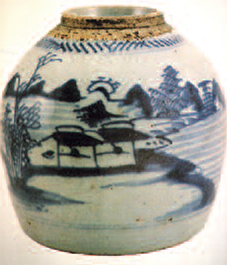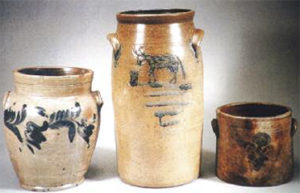 By Robert Reed
By Robert Reed
What began as a courtship of stoneware in early days of America became a full-fledged romance during the growing years of the country.
Stoneware, which had its origins in 16th century, became a very practical and attractive earthenware in England by the 17th century.
Being highly-fired and treated with common salt in the kiln process, the resulting stoneware was the next closest thing to porcelain. The amazing pottery was strong enough to be crafted in much thinner surfaces and yet was water-tight.
 Typically these utilitarian pieces were simply decorated with a pointed tool which incised the pottery in a classical manner. The ‘indentions’ were then filled with cobalt blue for accent. In some cases however the piece was not incised and the accompanying blue was simply dabbed on the surface.
Typically these utilitarian pieces were simply decorated with a pointed tool which incised the pottery in a classical manner. The ‘indentions’ were then filled with cobalt blue for accent. In some cases however the piece was not incised and the accompanying blue was simply dabbed on the surface. As life in 18th century America evolved stoneware containers became very useful and popular. Eventually during the latter part of that century, “every rural household was supplied with a variety of stoneware crocks, jugs, jars, milk pans and churns,” notes William Ketchum, Jr. author of All-American Folk Arts and Crafts.
And while only the basic blue was available, “the folk potter painted on these vessels as though he were working on the finest artist’s canvas. He brightened the kitchen and pantry with crocks, the surfaces of which were covered with flowers, birds,” and even fancier designs.
 Stoneware crafting was done on a relatively limited basis in the United States until the American Revolution. In Philadelphia, Anthony Duche claimed in 1730 to have been making stoneware “for several Years past.” In Boston, Thomas Symmes advertised in 1745 his inventory of “blue and white store ware of forty different kinds.”
Stoneware crafting was done on a relatively limited basis in the United States until the American Revolution. In Philadelphia, Anthony Duche claimed in 1730 to have been making stoneware “for several Years past.” In Boston, Thomas Symmes advertised in 1745 his inventory of “blue and white store ware of forty different kinds.” In 1779 raiding British soldiers apparently destroyed the stoneware pottery works owned and operated by General James Morgan along the Cheesquake Creek in New Jersey. Morgan eventually filed a claim for most of the loss, also mentioning, “1 kiln of Stoneware not burnt.”
Regions of New Jersey were among the best in the country at the time to find the right clay for forming stoneware. With the right elements the operation itself became fairly basic.
“The early potter’s dry clay, if washing was not necessary, was coarsely crushed with a sledge hammer or in some sort of simple mill,” observes Georgeanna Greet in the reference American Stonewares, Art and craft of Utilitarian Potters. “It was then mixed with water to make it the proper consistency for throwing on the wheel, It was in a slightly soft state about the consistency of bread dough.”
The simplicity of it all combined with the growing demand for it all early in the 19th century, was a boon for American potters.
The Congress of the United States passed a series of laws in the early 1800s, including the Embargo Act of 1807, to strictly limit trade with England. As a result imports dropped to a fraction of what they had previously been, and American potters were treated to a growing domestic market nearly free of foreign imports.
During this enlightened period some potters were known of have signed their stoneware works. Among them Xeres Price who stamped XP on his jars, and Peter Cross who simply wrote P. Cross. Accounts say Paul Cushman was crafting both redware and stoneware on a hill described as “a half mile west of Albany Gaol” in New York about the time of the War of 1812. Meanwhile, the diary of Hiram Harwood pointed out Captain John Norton was making “ware of both kinds, stone and clay” in 1815.
Interestingly enough stoneware potters could be found as far west as Ohio in the 1820s, and within the next 20 years at least 50 such craftsmen were said be operating in that region of the country. Clays from the basin of the Ohio River were reported to be even richer and in better supply than earlier sites in New Jersey and other eastern areas.
By the middle of the 19th century there were entire, factories producing fine and enduring Stoneware. Americans used jugs for everything from cider to vinegar. They also adopted stoneware crocks for dairy products, pots and bowls for mixing and cooking, and even as water coolers. Colors for the stoneware generally remained in the range of gray-white to medium brown, but there were some variations. Sizes, like uses, also varied greatly. Frequently they ranged for a mere half-gallon container to those holding 20 gallons. Larger sizes were typically more common to the marketplace.
There was a gradual increase in the use of decoratives such as birds and animals, and flowers. Borders including beading, as wells as leaves and fruit. More and more potters added names or identifying numbers. Sometimes the location of production was stamped on the stoneware, and in some cases the name of the dealer (instead of the maker) was stamped on an individual item.
Stenciled designs were particularly prevalent during the second half of the 19th century. Eagles were especially popular with Midwestern potters.
However it was the craftsman own personal mark which may have added the most in the long term. Sometimes the entire name and factory address was used. Today, “the inscription not only adds to the attractiveness of the piece,” offers Katharine McClinton in Antique Collecting for Everyone, “but it also helps locate Potteries and thus gives the piece historic value.”
Production and marketing of stoneware pieces remained widespread in United States during the 1880s and 1890s.
In 1895 the Montgomery Ward and Company offered a selection of stoneware that included churns ranging in capacity from two to eight gallons. The largest size retailed at $1.75 cents. The catalog also listed stoneware pots “for cooking cereals of any kind, such as oatmeal or cracked wheat. It has no equal for boiling bread and milk.” Also offered were light brown stoneware butter jars, and stoneware water coolers with cover and wooden faucet.
Production of stoneware continued into the 20th century with one government report for 1900 putting commercial yield of such wares at near $2 million dollars. A turn-of-the-century figure that was nearly four times the market level of redware.
Today collectors look for pieces in excellent condition with appealing bird and flower decorations. Authentic stoneware with other decorative images such as animals and ships is considered rare.
Besides decorations, coloring, shape, and proportions can add to the collectibility of stoneware items. Perfectly preserved pieces with the mark of early potters are highly desired and bring top prices at leading auction galleries.
Recommended reading: American Stonewares, Art and Craft of Utilitarian Potters by Georgenna Greer (Schiffer Publishing).















Follow Us